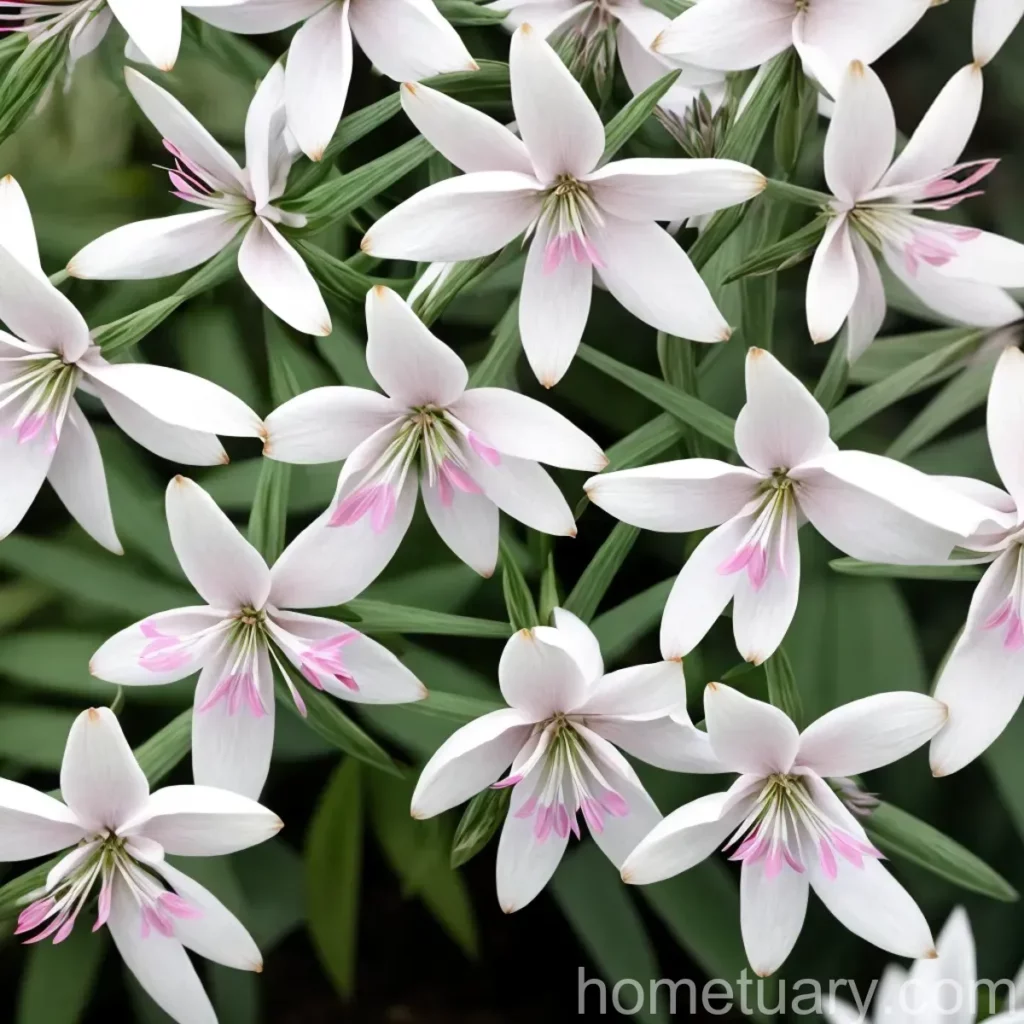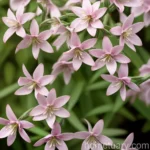The Beautiful Gaura (Gaura lindheimeri ‘Nugauwhite’ KARALEE WHITE)
In the world of gardening, there is a beautiful and fascinating plant known as Gaura (Gaura lindheimeri ‘Nugauwhite’ KARALEE WHITE). This graceful and delicate perennial is a popular choice for flower beds, borders, and containers. With its delicate blossoms and airy appearance, Gaura adds an ethereal charm to any garden setting.
In this comprehensive guide, we will explore the culture, uses, care requirements, and interesting facts about Gaura. Whether you are already a fan of this lovely plant or just discovering it for the first time, this article will serve as a valuable resource for understanding and cultivating Gaura in your own garden.
What is Gaura (Gaura lindheimeri ‘Nugauwhite’ KARALEE WHITE)?
Gaura, scientifically known as Gaura lindheimeri, is a native to North America. The ‘Nugauwhite’ variety, also called KARALEE WHITE, is particularly prized for its striking white flowers that bloom profusely from late spring to fall. This plant is commonly known by several other names including White Wandflower and Lindheimer’s Beeblossom. Its slender stems bear clusters of delicate, four-petaled blossoms, creating a charming display reminiscent of butterflies fluttering in the wind.
Key Takeaways – gaura (Gaura lindheimeri ‘Nugauwhite’ KARALEE WHITE)
Before delving into the specific aspects of Gaura culture and care, let us highlight some key takeaways about this stunning plant.
- Gaura lindheimeri ‘Nugauwhite’ Characteristics:
- Slender, wiry stems
- White, four-petaled flowers
- Graceful, airy appearance
-
Long blooming period
-
Gaura lindheimeri ‘Nugauwhite’ Uses:
- Ideal for flower beds, borders, and containers
- Attracts pollinators like bees and butterflies
-
Adds a touch of elegance to garden landscapes
-
Gaura lindheimeri ‘Nugauwhite’ Growing Tips:
- Requires well-draining soil
- Thrives in full sun
- Drought-tolerant once established
Now, let’s delve into the specific aspects of Gaura care, including its water, sunlight, fertilizer, soil, pruning, propagation, and more.
Culture
Water
Gaura is a relatively low-maintenance plant when it comes to water requirements. It is important to ensure that the soil is well-draining to prevent waterlogging, which can be detrimental to the plant’s health. Once established, Gaura is quite drought-tolerant and can withstand periods of reduced rainfall. However, during extended dry spells, it is advisable to provide supplemental watering to support healthy growth and prolific flowering.
Sunlight
Gaura thrives in full sun, making it an excellent choice for sunny garden spots. It requires a minimum of six to eight hours of sunlight daily to flourish and produce an abundance of blossoms. Insufficient sunlight may lead to leggy growth and reduced flowering. Therefore, when selecting a planting location for Gaura, be sure to choose a spot that receives ample sunlight throughout the day.
Fertilizer
When it comes to fertilizing Gaura, less is more. This plant does not require heavy feeding and excessive fertilization may lead to leggy growth with fewer blooms. A balanced, slow-release fertilizer applied in early spring as new growth emerges is often sufficient to provide the necessary nutrients for healthy Gaura plants. Be cautious not to over-fertilize, as this can negatively impact the plant’s overall vigor and flowering.
Soil
Gaura thrives in well-draining soil with a slightly acidic to neutral pH. It is essential to ensure good soil drainage to prevent the risk of root rot, particularly in regions with heavy rainfall. Sandy or loamy soils are well-suited for Gaura cultivation, providing the optimal growing conditions for this graceful perennial. Consider amending the soil with organic matter to improve its texture and drainage, which is especially beneficial in clay-heavy soils.
Pruning
One of the appealing characteristics of Gaura is its naturally graceful and airy growth habit. Minimal pruning is generally required, except for the removal of spent flowers to encourage continuous blooming. Pruning can be performed by simply snipping off the faded flower spikes at their base. However, it is important to leave some seed heads on the plant if you want to encourage self-seeding, as Gaura readily produces seeds for the next growing season.
Propagation
Gaura can be propagated through several methods, including division, stem cuttings, or seed sowing.
-
Division: Divide mature clumps of Gaura in early spring or fall to create new plants. Carefully lift the plant and separate the root mass into smaller sections, ensuring that each division has sufficient roots and vigorous growth points.
-
Stem Cuttings: Take 4-6 inch stem cuttings from healthy, non-flowering shoots and remove the lower leaves. Dip the cut ends in a rooting hormone before planting them in a well-draining potting mix. Place the cuttings in a warm, bright location and keep the soil consistently moist until roots develop.
-
Seed Sowing: Gaura readily self-seeds, producing viable seeds that can be collected and sown for new plantings. In late summer to early fall, collect the mature seeds and sow them directly into the garden bed or in containers. The seeds require light for germination, so simply press them lightly into the soil surface and keep the area consistently moist until germination occurs.
Container Popularity
Gaura’s compact and upright growth habit makes it well-suited for container cultivation. When grown in containers, Gaura can adorn patios, decks, and balconies with its elegant presence. The airy blossoms and gently swaying stems bring a sense of movement and grace to container gardens, creating a captivating display of white flowers against the backdrop of foliage or other companion plants.
Container Tips for Gaura:
- Select a container with adequate drainage holes to prevent waterlogging.
- Use a well-draining potting mix formulated for flowering perennials.
- Position the container in a sunny location to ensure optimal sunlight exposure.
- Regularly check the moisture level of the soil and water as needed to keep it consistently moist but not waterlogged.
Common Diseases
Gaura is generally resistant to most diseases and is not commonly plagued by serious health issues when grown in favorable conditions. However, there are certain factors that may contribute to the development of diseases in Gaura, including poor air circulation, overwatering, and nutrient deficiencies. Being mindful of these factors and providing proper care can help prevent and mitigate potential disease problems.
Disease diagnosis
- Powdery Mildew: A fungal disease that manifests as a powdery, white coating on the leaves and stems. It thrives in conditions of high humidity and poor air circulation.
Preventive measures: Ensure good air circulation around plants, avoid overhead watering, and promptly remove and destroy affected plant parts.
- Root Rot: This disease occurs as a result of waterlogging and poorly draining soil, leading to rotting of the root system.
Preventive measures: Plant Gaura in well-draining soil, avoid overwatering, and improve soil drainage if necessary.
Common pests
In addition to diseases, Gaura may also be susceptible to certain pests that can affect its overall health and vigor.
- Aphids: These small, soft-bodied insects feed on the sap of plants, causing stunted growth and distorted leaves.
Control measures: Use insecticidal soap or neem oil to control aphid infestations, or introduce natural predators such as ladybugs or lacewings.
- Spider Mites: These tiny arachnids thrive in hot and dry conditions, causing stippling and discoloration of leaves.
Control measures: Maintain adequate humidity levels, apply horticultural oil, and regularly spray plants with water to deter spider mite infestations.
Now that we have covered the essential aspects of Gaura care and maintenance, let’s explore some additional tips from a botanist’s perspective and discover some interesting fun facts about this captivating plant.
Botanist’s Tips
As a plant scientist with a deep appreciation for the intricate beauty of Gaura, I offer the following tips to enhance your experience of growing and tending to this remarkable perennial:
-
Encourage Wildlife Habitats: Gaura attracts a variety of pollinators, including bees and butterflies, with its nectar-rich flowers. By planting Gaura in your garden, you can create a welcoming habitat for these beneficial insects and contribute to the overall biodiversity of your local ecosystem.
-
Embrace Its Natural Grace: Allow Gaura to sway gently in the breeze, embracing its natural penchant for movement. The fluidity of its slender stems and delicate blossoms adds a sense of tranquility and movement to garden landscapes.
-
Celebrate Self-Seeding: Gaura readily self-seeds, producing viable seeds that can give rise to new generations of plants. Embrace this natural process by allowing some seed heads to mature and scatter their seeds, ensuring the continued presence of Gaura in your garden.
-
Combine with Complementary Plants: Pair Gaura with companion plants that complement its elegance and enhance its visual appeal. Consider combining it with ornamental grasses, salvias, or other pollinator-friendly perennials for a captivating display.
Fun Facts
As an advocate for the appreciation of botanical wonders, I find it fitting to share some intriguing and delightful fun facts about Gaura:
-
Evening Dancer: Gaura is sometimes referred to as the “Evening Dancer” due to the mesmerizing way its blossoms seem to dance and sway in the evening breeze, creating a captivating spectacle in the garden.
-
Fragrant Blooms: While Gaura is not primarily known for its fragrance, some cultivars may exhibit a delicate, sweet scent, particularly in the evening hours when the flowers release their subtle perfume.
-
Native American Use: Historically, certain Native American tribes utilized Gaura for its medicinal properties, employing it as a remedy for various ailments. The roots and leaves were used to create infusions and poultices for treating specific health conditions.
Now that we have gained a deeper understanding of Gaura as a plant, it is important to explore further resources for those who wish to cultivate and appreciate this enchanting perennial. The following links provide valuable insights and information for enthusiasts and gardeners interested in learning more about Gaura.
Links to External Resources
- Gaura: A Gardener’s Guide
- Planting and Caring for Gaura
- The Joy of Growing Gaura
- Gaura lindheimeri ‘Nugauwhite’ Profile
In conclusion, the enchanting Gaura (Gaura lindheimeri ‘Nugauwhite’ KARALEE WHITE) embodies a delicate elegance and natural grace that enhances any garden setting. With its long-blooming white flowers and low-maintenance nature, Gaura is a beloved choice for gardeners seeking to introduce a touch of ethereal beauty to their outdoor spaces. By understanding its cultural requirements, potential uses, and fascinating attributes, one can fully appreciate the allure of Gaura and cultivate a thriving, enchanting garden with this remarkable plant at its heart.















